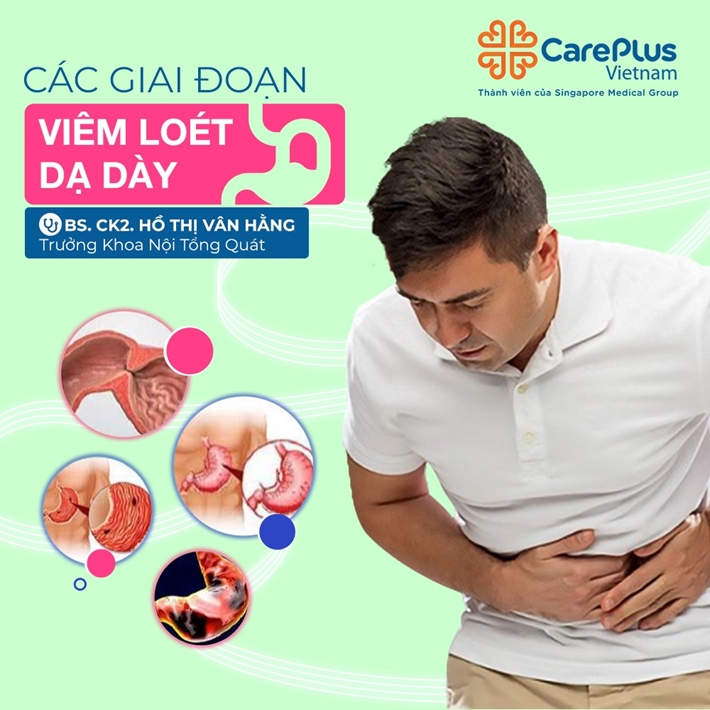Các giai đoạn viêm loét dạ dày
Viêm loét dạ dày được chia làm 2 giai đoạn là viêm loét cấp tính và mãn tính.

10/08/2022 2:00:18 CH
1. Viêm loét dạ dày cấp tính
Dấu hiệu đặc trưng của viêm loét dạ dày cấp tính là các triệu chứng thường xuất hiện đột ngột, biểu hiện rõ nét và diễn tiến trong thời gian ngắn. Ở giai đoạn này, nếu được phát hiện và điều trị đúng cách, bệnh hoàn toàn có thể chữa khỏi triệt để. Tuy nhiên, đa số người bệnh thường bỏ qua các triệu chứng, chủ quan không đi khám, khiến bệnh tình trở nên phức tạp hơn.
2. Viêm loét dạ dày mãn tính
Viêm loét dạ dày cấp tính khi không được điều trị sẽ khiến tình trạng viêm sưng kéo dài, sau một thời gian có thể chuyển sang dạng mãn tính. Ở giai đoạn mãn tính, các tổn thương lan rộng, bệnh khó điều trị hơn, thậm chí có thể dẫn đến những biến chứng nguy hiểm như viêm teo, chuyển sản ruột, hẹp môn vị, xuất huyết, thủng, ung thư dạ dày, viêm nhiễm các cơ quan lân cận…
Nguyên nhân gây bệnh viêm loét dạ dày
Viêm loét dạ dày có thể do nhiều nguyên nhân khác nhau gây ra. Trong đó, hai nguyên nhân phổ biến nhất là:
1. Nhiễm vi khuẩn Helicobacter. pylori (vi khuẩn HP)
Nhiễm H.pylori là nguyên nhân hàng đầu gây viêm loét dạ dày. Sau khi xâm nhập vào dạ dày, vi khuẩn này sẽ chui vào lớp nhầy của niêm mạc dạ dày, tiết ra độc tố làm tổn thương niêm mạc dạ dày, ức chế sản xuất yếu tố bảo vệ niêm mạc dạ dày hình thành các vết loét.
2. Sử dụng lâu dài thuốc chống viêm không steroid (NSAID)
Việc sử dụng các loại thuốc NSAID như ibuprofen, naproxen, diclofenac… trong thời gian dài sẽ khiến dạ dày bị tổn thương. Các loại thuốc này gây ức chế quá trình tổng hợp prostaglandin, làm giảm hiệu quả bảo vệ niêm mạc dạ dày, khiến dạ dày dễ bị viêm loét.
Bên cạnh hai nguyên nhân trên, bệnh còn có thể do các nguyên nhân ít gặp hơn gây ra, bao gồm:
-
Tăng tiết axit trong dạ dày: Điều này có thể xảy ra vì nhiều lý do, bao gồm yếu tố di truyền, hút thuốc lá, căng thẳng hoặc tiêu thụ một số loại thực phẩm nhất định.
-
Hội chứng Zollinger-Ellison: Đây là một tình trạng hiếm gặp gây ra tình trạng dư thừa axit trong dạ dày.
Viêm loét dạ dày là một trong những bệnh lý đường tiêu hóa phổ biến nhất. Nếu như được phát hiện sớm, bệnh có thể dễ dàng chữa khỏi, tránh tình trạng bệnh sẽ tiến triển nặng và có thể dẫn đến biến chứng.
Vì vậy, việc chủ động thăm khám và điều trị các bệnh lý, xây dựng lối sống lành mạnh và chế độ dinh dưỡng khoa học là điều hết sức cần thiết. Đặt lịch khám với bác sĩ CarePlus để nhận được những lời khuyên, thông tin chính xác, đồng thời điều trị bệnh kịp thời ngay khi gặp những triệu chứng bất thường.